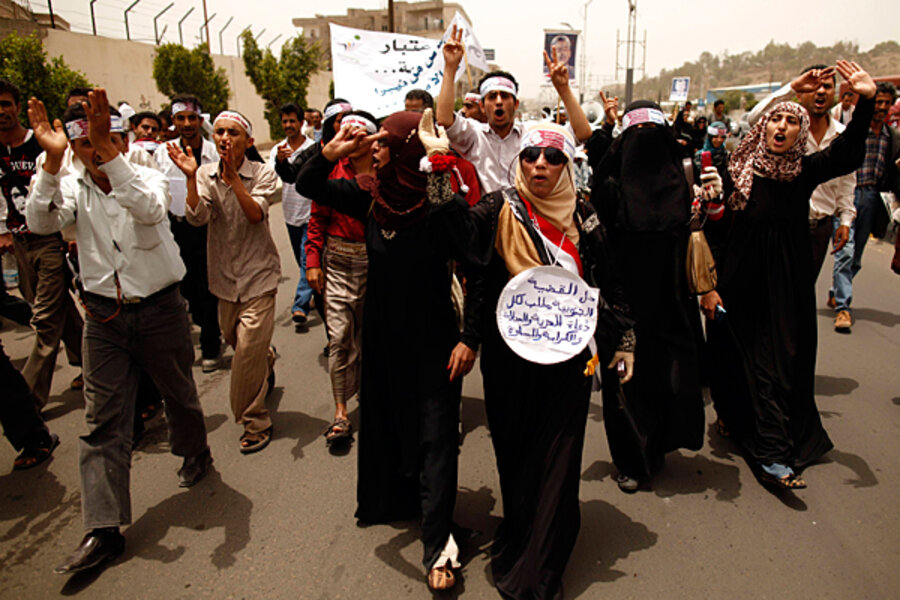Yemen's power vacuum could provide window for secessionists
Loading...
| Aden and Sanaa, Yemen
In the former southern Yemen capital of Aden, secessionist leaders who once served jail terms for their political activities openly lead demonstrations, while the pre-unification flag, once forbidden, is a nearly constant presence in the sweltering city’s streets.
Yemen’s Southern Movement has emerged defiantly from the power vacuum caused by last year’s uprising against former President Ali Abdullah Saleh. Though the Yemeni government and the bulk of the international community still see Yemen’s continued unity, forged in 1990, as nonnegotiable, many emboldened separatists increasingly feel they’re on the verge of restoring their independence.
And while the leaders of this divided movement stress that they’re committed to waging a peaceful struggle, some are quietly raising the specter that long-festering wounds dating from Yemen’s unification could doom the country’s post-Saleh transition.
Though both sides hailed it as a triumph at the outset, the optimism that followed the 1990 unification of the socialist People’s Democratic Republic of Yemen (PDRY) and the northern Yemen Arab Republic (YAR) was short-lived. Barely four years after unity was declared, building tensions erupted into a north-south civil war, briefly threatening to tear the new country apart. The fighting ended with a decisive victory for northern pro-unity forces and the exile of the bulk of the south’s leadership.
Military defeat, however, failed to eradicate southerners’ grievances, and as northern elites strengthened their grip on the south, feelings of alienation from the central government only continued to grow.
The Southern Movement emerged in 2007 as a rights-based movement, but in the face of a repressive response from a seemingly unsympathetic government, it soon radicalized into a secessionist grouping. Unification, activists argue, has amounted to occupation by the government in Sanaa. While corrupt elites in Sanaa seized swaths of lands and pocketed the profits of the south’s natural resources, southerners were left empty handed, suffering from an anemic economy, sky-high unemployment and government discrimination. Conservative influence from the largely tribal north erased the “civil society” engendered by British colonization and socialist rule.
“Since unification, we’ve been robbed of all of our benefits and had a backwards, tribal regime pushed on us,” says Mohsen Abed Said, a socialist activist in Aden. “It's not shocking that most southerners want to restore our independent state.”
Factions struggle to overcome differences
While its gained support by tapping into pervasive discontent with the central government, the Southern Movement is a fractious coalition that, for the moment, exists as a single movement in name only. Activists say transforming the cacophony of separatist factions into a coherently organized group is a top priority. A recent conference attended by a number of leading Southern Movement figures concluded with a statement laying out plans for creation of a single council that would function as a central, representative ruling body for the group. But any efforts to add structure to the group will likely face steep challenges.
Even if they’re united in opposition to the current situation, those under the umbrella of the Southern Movement are split by political, ideological, and regional differences. Memories of the conflicts of the recent past, most notably the 1986 civil war, an elite power struggle that devolved into a brutal, 12-day conflict that left thousands dead, also impede unification.
On the ground, the influence of factions is often limited to specific regional constituencies, and while some have touted them as the movement’s ostensible heads, exiled leaders like former presidents Ali Nasser Mohamed and Ali Salem al-Beidh remain deeply controversial figures.
But as they attempt to organize, Southern Movement leaders will also be forced to reckon with a constituency still reeling from the fallout from the past year’s unrest, a government prone to characterizing secessionists as agents of chaos, and defiant extremists angry about being pushed from their strongholds in the southern Abyan Province.
In Aden, rising crime and violence have residents complaining of the seeming breakdown of any sense of order. At least five people have been killed at secessionist demonstrations in the past month, while a recent uptick in clashes between security forces and armed separatists has led some to conclude that movement’s leaders’ are losing the ability to rein in extremists within their ranks.
Although Yemeni politicians and international diplomats remain publicly focused on the upcoming national dialogue process, a key precursor to drafting a new constitution that’s expected to include the participation of southern leaders, the confrontations in Aden have raised fears that the situation there could spiral out of control. And while reasserting their commitments to nonviolence, some activists quietly admit that in the absence of progress, a shift to armed insurrection in some factions is far from unimaginable.
“We still believe in the peaceful struggle and I believe that, with the aid of the international community, we can achieve our goals,” said one elderly separatist leader, prior to alluding to the armed insurgency that brought an end to the century-long British colonization of Aden. “Look, we pushed the British out, and we’ll push the northerners out. It’s not my decision how: That’s for the Southern people to decide.”







